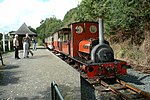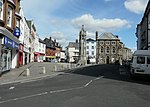Launceston ( LAHN-stən, LAWN-, locally LA(H)N-sən; rarely spelled Lanson as a local abbreviation; Cornish: Lannstevan) is a town, ancient borough, and civil parish in Cornwall, England, United Kingdom. It is 1 mile (1.6 km) west of the middle stage of the River Tamar, which constitutes almost the entire border between Cornwall and Devon. The landscape of the town is generally steep particularly at a sharp south-western knoll topped by Launceston Castle. These gradients fall down to the River Kensey and smaller tributaries.
The town centre itself is bypassed and is no longer physically a main thoroughfare. The A388 still runs through the town close to the centre. The town remains figuratively the "gateway to Cornwall", due to having the A30, one of the two dual carriageways into the county, pass directly next to the town. The other dual carriageway and alternative main point of entry is the A38 at Saltash over the Tamar Bridge and was completed in 1962. There are smaller points of entry to Cornwall on minor roads.
Launceston Steam Railway narrow-gauge heritage railway runs as a tourist attraction during the summer months. It was restored for aesthetic and industrial heritage purposes and runs along a short rural route, it is popular with visitors but does not run for much of the year.
Launceston Castle was built by Robert, Count of Mortain (half-brother of William the Conqueror), c. 1070 to control the surrounding area. Launceston was the caput of the feudal barony of Launceston and of the Earldom of Cornwall until replaced by Lostwithiel in the 13th century. Launceston was later the county town of Cornwall until 1835 when Bodmin replaced it.
Two civil parishes serve the town and its outskirts, of which the central more built-up administrative unit housed 8,952 residents at the 2011 census.Three electoral wards include reference to the town, their total population, from 2011 census data, being 11,837 and two ecclesiastical parishes serve the former single parish, with three churches and a large swathe of land to the north and west part of the area.
Launceston's motto "Royale et Loyale" (English translation: Royal and Loyal) is a reference to its adherence to the Cavalier cause during the English Civil War of the mid-17th century.






